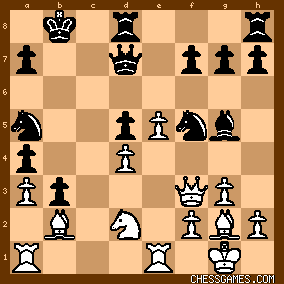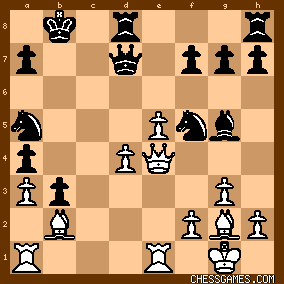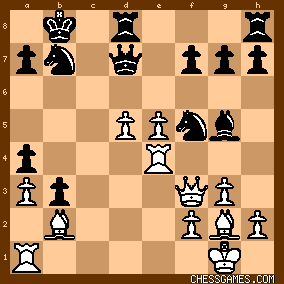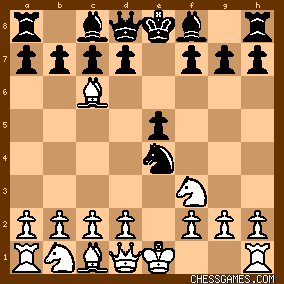| Sep-04-16 | | yadasampati: Ha, i saw it in less than a minute! Intuition did it again. I saw the devastating threat of Qa8+ and Rc1+ and first thought about deflecting the d5 pawn to c4. But then i realized that Ne4! also did the job |
|
| Sep-04-16 | | bcokugras: Have a nice Sunday. If the black plays 23. ... Qxd5, then what does the white play? |
|
Sep-04-16
 | | al wazir: After 21...dxe4, why didn't white play 22. Qxe4, attacking along the long diagonal? And what if black plays 21...Be7 instead of 21...dxe4 ? If now 22. Nc5, then 22...Bxc5 23. exc5 Nc6, and white is going to have a hard time opening up that diagonal. |
|
Sep-04-16
 | | al wazir: <bcokugras: If the black plays 23. ... Qxd5, then what does the white play?> My guess was 24. Qxf5. If now 24...Be7, then 25. Rb4. |
|
| Sep-04-16 | | drollere: material is equal, but black has more space and a few specific threats, including Bxd2 or Nc4 -- which can't be captured without creating linked passed pawns. if only the p at d5 were out of the way, white could play Qa8+, Rc1+ and Rc6#. but this can be blocked by Qb7 or Nb7. so the Q has to be bumped off the 7th rank, or the threat by the Q used to leverage the pawn advance. 21. Ne4 pxe4
22. Qxe4
i missed Rxe4, which keeps the threat on the N at f5, because i wanted to clear the diagonal. i didn't like Nb7 because then the R has a check or pin at b4 and the B has a check at e5. seeing only the first move doesn't count for much. 13/18 |
|
| Sep-04-16 | | Cheapo by the Dozen: I blew my calculations, because I overlooked that Black's bishop covered c1, and hence I relied on the possibility of Rc1+. So the whole thing looked easier to me in the accepted-sacrifice case than it was. I didn't see anything particularly crushing if Black declines the sacrifice and retreats with ... Be7 so as to cover c5 and d6. But given my other (erroneous) calculations, I'd have played the puzzle's first move anyway. |
|
| Sep-04-16 | | devere: <bcokugras: Have a nice Sunday. If the black plays 23. ... Qxd5, then what does the white play?> 24.Qxf5 |
|
| Sep-04-16 | | diagonalley: <diagonalley> nul points :-( |
|
| Sep-04-16 | | stacase: 21.Ne4 I just don't understand why Black fell for it. |
|
| Sep-04-16 | | morfishine: I got <21.Ne4> and drafted a helluva FF team last night |
|
| Sep-04-16 | | RandomVisitor: 
click for larger viewKomodo-10.1-64bit:
<+0.96/41 21.Ne4 Be7> 22.Nc5 Bxc5 23.dxc5 Nc4 24.c6 Qc7 25.Qxf5 Nxb2 26.e6 fxe6 27.Rxe6 Rhf8 28.Qg4 Ka8 29.Rf1 Nc4 30.Bxd5 Rxd5 31.Qxc4 Rd2 32.Qxa4 Qb6 33.Qe4 Rc8 34.Re8 Rxe8 35.Qxe8+ Rd8 36.Qe4 Rc8 37.Rb1 Qxc6 38.Qxc6+ Rxc6 39.Rxb3 Rc7 40.f4 a6 41.Kg2 Ka7 42.Kf3 a5 43.Ke4 Ka6 44.Kd5 Rc1 45.Re3 Rd1+ 46.Ke6 Kb5 47.Rc3 g6 48.Rc7 |
|
| Sep-04-16 | | AlicesKnight: <al-wazir> may be right, but after 21.Ne4 Be7; 22.Nc3 how does Black protect the d-pawn (...Ne7 is now impossible)? Perhaps by counter-attacking with ...Nc6 (also guarding a8)? It all suggests that taking the N made problems much worse. And no, I didn't get it.... |
|
| Sep-04-16 | | YouRang: Insane Sunday 21.?

click for larger view
Observations:
- I (white) have a Q+B battery aimed at black's king, but it's blocked by black's Pd5. - Black's DSB is attacking my unguarded Nd2.
That Pd5 is well-defended, so the best chance of removing it appears to be a sac, any my attacked knight seems to be the piece to offer, since it can go to c4 or e4. 21.Nc4 won't work since can be answered by ...Nxc4, so I'm thinking <21.Ne4 dxe4 22.Qxe4>

click for larger view
White has serious threats now with Qa8+ and Qxa7+, and what can black do to stop it? - 22...Nc6 blocks the diagonal, but the N is assailable (maybe h4 to kick the DSB so I can play Rc1). - 22...Nb7 also blocks the diagonal, and this seems to be a tougher nut. Maybe d5 with idea of e5 and Be5+, but it's too vague for me to see how it goes. ~~~~
I was more or less on the right track, but missed the more patient <22.Rxe4!>, which creates additional threats. The chief threat is 23.Rf4! (23...Bxf4? leads to sort of a windmill mate: 24.Qa8+ Kc7 25.Qxa7+ Kc8 26.Qa8+ Kc7 27.Qxa5+ Kc8 28.Qa8+ Kc7 29.Qb7#). Black played <22...Nb7> (best), but then <23.d5!>

click for larger view
Now, the biggest threat is d6 (re-opening the diagonal) and Rxa5 (...Qxa5? Qxb7#). Black soon fell in the complications. The best defense was probably 23...Nfd6 (give back the N), but even so, 24.exd6 Rhe8 25.Rg4, and white is clearly has all the initiative, and is probably winning. |
|
| Sep-04-16 | | agb2002: White has the bishop pair for a bishop, a knight and a pawn. Black threatens Bxd2 and Nc4 if the white knight moves. White has a number of moves to try to make the most of the airy position of the black king: e6, Qc3, Qd3, Bh3, Ne4, Rad1, Bc3, etc. Some of them apparently lead to a lost position. For example, 21.Bc3 Bxd2 22.Bxd2 Nxd4 23.Qc3 Nac6. Or 21.Rad1 Bxd2 22.Rxd2 Nc4 23.Rde2 Nxb2 24.Rxb2 Nxd4 followed by Nc2. By elimination, only 21.Ne4 seems to have practical value: A) 21... dxe4 22.Qxe4
A.1) 22... Qb7 23.Qxf5 Qe7 24.e6 with several threats (Qxa5, Qb5+, exf7, etc.) looks very good for White. A.2) 22... Rc8 23.Qa8+ Kc7 24.Qxa7+ Kd8 (24... Nb7 25.Qxb7+) 25.Qxa5+ and White has an extra pawn and a much better position. A.3) 22... Nb7 23.f4 with the plan Rac1, Rc4, Rb4 combined with d5, d6. B) 21... h6 22.Nc5 Qc8 23.Nxa4 recovers the pawn with a much better position. C) 21... Be7 22.Nc5 Bxc5 23.dxc5 Nc4 unclear.
That's all I can do today. |
|
| Sep-04-16 | | patzer2: Since it's a Sunday puzzle, it must be an insane move. So I figured what could be more insane than sacrificing a piece with 21. Ne4! However, after 21...dxe4 I had planned on following up with 22. Qxe4?! Unfortunately, 22. Qxe4?! doesn't pack as much punch as the game move 22. Rxe4! After 22. Qxe4?!, Deep Fritz 15 indicates Black stands better after 22. Qxe4 Nb7 as play might continue 23. d5 Rhe8 24. Qf3 g6 25. d6 Bd2 26. Re2 Ba5 27. Re4 Bb6 28. Rxa4 f6 29. exf6 Nfxd6 30. Rb4 Qf5 31. Rxb3 Rc8 32. Rd1 Ne4 33. Qxf5 gxf5 34. Bxe4 fxe4  (-1.06 @ 22 depth, Deep Fritz 15). (-1.06 @ 22 depth, Deep Fritz 15). In contrast to 22. Qxe4?!, which leaves White about a pawn worse, the game move 22. Rxe4, as indicated by <RV>'s 41 ply deep analysis with Komodo 10, leaves White about a pawn better. In the game continuation, after 21. Ne4 dxe4 22. Rxe4 Nb7 23. d5 Black's decisive mistake was 23...Ne7? allowing 24. d6  (+2.84 @ 19 depth, Deep Fritz 15). (+2.84 @ 19 depth, Deep Fritz 15). Instead, 23...Nfd6 keeps Black in the fight as play might continue 24. exd6 Rhe8 25. Rg4  (+0.74 @ 22 depth, Deep Fritz 15). (+0.74 @ 22 depth, Deep Fritz 15). P.S.: On an unrelated note, I'm really proud of my 7-year-old Grandson. Yesterday (Saturday, Sep 3, 2016), he scored three wins and one draw in five rounds of swiss play in the K-12 under 1000 section of the Southwest Open in Irving, Texas. He was up a Rook and a Knight to a Rook when he offered his opponent his one draw. In his one loss to the highest rated player in the section, he was up two rooks in an easily won position but got swindled after he overlooked a simple mate threat. However, he was elated as there were trophies for the top 12 players in his 56 person section and he got a nice trophy for twelfth place. He has two more tournaments scheduled for next month, and we're hoping he gains the 80 rating points he needs to break 1000 which would put him in the top 100 7-year-old players in the USA. |
|
| Sep-04-16 | | patzer2: Scholastic play can be amusing. In my Grandson's first game as White in yesterday's Southwest Open (K-12 under 1000 section_), play went 1. e4 e5 2. Nf3 Nc6 3. Bb5 Nf6 4. Bxc6 Nxe4? (diagram below)
click for larger view5. Bxe4  . .
P.S.: As 4...Nxe4? above illustrates, not all "insane" moves are good moves. |
|
| Sep-04-16 | | Aleman: Of course Ne4 was my choice. Too hard to analyse after that though. |
|
| Sep-04-16 | | 1stboard: After white plays 21 ... Ne4 ( Do not know why black takes ) , what is wrong with black playing 21 ... Nc4 ??? |
|
| Sep-04-16 | | patzer2: <1stboard> If 21...Nc4, Deep Fritz 15 indicates White wins after 22. Nxg5 Nxb2 23. e6 fxe6 24. Nxe6  (+3.35 @ 17 depth). (+3.35 @ 17 depth). |
|
| Sep-08-16 | | Moszkowski012273: 27.RxQ... was quite incorrect. |
|
|
|
|





































